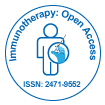
Immunotherapy: Open Access
Open Access
ISSN: 2471-9552

ISSN: 2471-9552
Commentary - (2024)Volume 10, Issue 4
Tumor mutational burden (TMB) refers to the number of mutations present in the Deoxyribonucleic Acid (DNA) of cancer cells. This parameter has gained considerable attention in the context of immunotherapy, especially regarding the effectiveness of immune checkpoint inhibitors. In theory, tumors with a higher TMB should produce more neoantigens-new, abnormal proteins that the immune system can recognize as unfamiliar. The immune system, in turn, should be able to target and destroy cancer cells more effectively. However, the relationship between TMB and immunotherapy resistance is complex and not all tumors with high TMB respond to treatment, nor do all tumors with low TMB fail to respond. Understanding the details of TMB in immunotherapy can provide observations into resistance mechanisms and guide more personalized treatment approaches.
Tumor mutational burden and immunotherapy
The rationale for using TMB as a biomarker for immunotherapy response is based on the idea that tumors with a high mutational burden are more likely to present a variety of novel antigens or neoantigens, on their surfaces. These neoantigens can be recognized by the immune system, particularly by T cells, which can then activate an immune response against the cancer.
Immunotherapies, such as immune checkpoint inhibitors, are designed to improve the immune system's ability to recognize and attack these tumor cells. For example, drugs like pembrolizumab and nivolumab, which block the Programmed Cell Death Protein 1(PD-1) pathway, have been shown to be more effective in tumors with high TMB. Tumors with a higher number of mutations often have a higher chance of producing neoantigens that can be targeted by the immune system, making them more responsive to immunotherapy. In several cancer types, including Non-Small Cell Lung Cancer (NSCLC), melanoma and Microsatellite Instability-High (MSI-H) tumors, TMB has been associated with better outcomes following immune checkpoint inhibitor treatment.
The complexity of tumor mutational burden in immunotherapy resistance
Despite its role as a predictor of immunotherapy response, TMB does not always correlate with treatment success, highlighting its limitations. There are several reasons for this inconsistency.
Genetic heterogeneity of tumors: Tumors are not homogeneous, they contain a mixture of cancer cells with different genetic profiles. This intratumoral heterogeneity can complicate the predictive power of TMB. Some tumor cells may have a high mutational burden and express neoantigens, while others may have fewer mutations and escape immune detection. As a result, tumors with a high TMB may still contain subclones that can resist immune attack, leading to treatment failure.
Immune evasion strategies: Even when a tumor produces neoantigens, it may not always trigger an effective immune response. Cancer cells often develop various immune evasion strategies to escape detection, such as the up regulation of immune checkpoint proteins, which suppress the immune system. These mechanisms can prevent T cells from recognizing and attacking the tumor, regardless of the mutational burden. In some cases, tumors with high TMB can evolve resistance through these immune checkpoints, diminishing the effectiveness of immunotherapy.
Tumor Microenvironment (TME): The TME plays an important role in determining how the immune system interacts with a tumor. An immunosuppressive TME can inhibit the activity of immune cells, even in tumors with high TMB. For example, the presence of regulatory T cells or Myeloid-Derived Suppressor Cells (MDSCs) in the TME can reduce the immune response, making it difficult for T cells to attack the cancer cells. Additionally, the physical barriers in the TME, such as dense extracellular matrix components, can limit the infiltration of immune cells into the tumor.
Tumor evolution and clonal selection: Over time, tumors can evolve and select for subclones that are more resistant to immune detection. While the original tumor may have had a high TMB and been susceptible to immunotherapy, the emergence of new, less immunogenic subclones can lead to resistance. This clonal evolution is a well-known feature of cancer biology and poses a significant challenge to the long-term effectiveness of immunotherapies.
Moving toward a more comprehensive approach
Given the complexity of TMB and its variable role in immunotherapy resistance depending exclusively on TMB as a predictor of response may not be sufficient. Researchers are increasingly advocating for a more comprehensive approach that combines TMB with other biomarkers, such as Microsatellite Instability (MSI), tumor-specific mutations and the overall immune profile of the patient.
Additionally, new technologies are emerging to better measure TMB and assess its relationship with other factors in the tumor microenvironment. For example, single-cell sequencing techniques are helping researchers study the genetic diversity of tumors at a more granular level, providing a deeper understanding of how mutational burden and immune resistance factors interact. Moreover, combination therapies that target both the tumor and the immune microenvironment are showing potential. For instance, combining immune checkpoint inhibitors with agents that modulate the TME or target other immune pathways could help overcome the resistance that some high-TMB tumors develop.
TMB has proven to be an important factor in predicting the success of immunotherapy, particularly for immune checkpoint inhibitors. However, its role in immunotherapy resistance is not straightforward. Tumor heterogeneity, immune evasion mechanisms and the tumor microenvironment all contribute to the complexity of TMB’s predictive power. To improve the efficacy of immunotherapy and overcome resistance, a more detailed and complex approach is needed. By combining TMB with other biomarkers and innovative treatment strategies, researchers and clinicians can work toward more personalized and effective cancer therapies.
Citation: Hannah K (2024). Advancing Tumor Mutational Burden: Enhancing Cancer Treatment Strategies with Genetic Profiling. Immunotherapy (Los Angel). 10:264.
Received: 20-Nov-2024, Manuscript No. IMT-24-36086 ; Editor assigned: 22-Nov-2025, Pre QC No. IMT-24-36086 (PQ); Reviewed: 09-Dec-2024, QC No. IMT-24-36086 ; Revised: 16-Dec-2024, Manuscript No. IMT-24-36086 (R); Published: 23-Dec-2024 , DOI: 10.35248/2471-9552.24.10.264
Copyright: © 2024 Hannah K. This is an open-access article distributed under the terms of the Creative Commons Attribution License, which permits unrestricted use, distribution and reproduction in any medium, provided the original author and source are credited.